The Lid and Secret Holding Tank #2
As we removed the sections of hose and pipe we discovered that the smell in the foc'shole was partly due to permeation, but that the real culprit could be observed on the rear of the two hoses that run from the holding tank area into the bilge: two thin long brown stains on the underside. Evidently, we had at least two leaks on our hands. When removed the bilge cover (below) we discovered just how bad the leaks were.
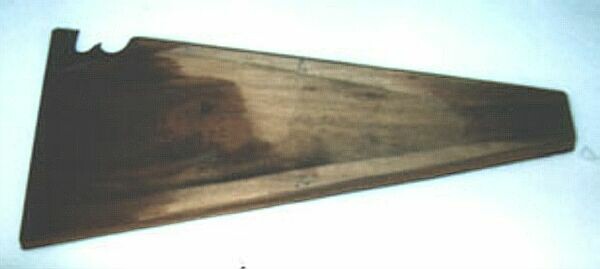
The Bilge cover (airex/balsa) had some funky mold and other stains on it because the floor it was resting on was wet with water and human waste.
Note the lack of epoxy or other sealants to protect the wood. Even after an entire fall and winter, the underside of the cover was still damp with the liquid that had accumulated. This piece of scrap lumber was the Prout catamaran substitution for a proper bilge hatch and was held in place with three screws. Unfortunately, the screws had dissuaded us to examine the bilge more closely - a big mistake! Since then, the hatch is no longer screwed down.
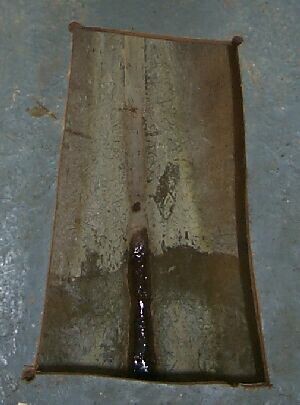
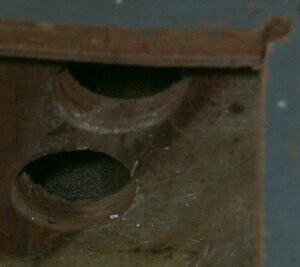
This is what the cover was hiding: "secret holding tank #2" (i.e. the bilge).
In the interest of not grossing everyone out, we had removed nearly all human waste by the time we took this picture. Interestingly enough, some of it had frozen and we had to heat it to get it out.
However, the light stain gives you a good idea just how much was in there (which was disposed of in a regular toilet at the marina). If you're wondering why the level of waste did not reach higher, it's because the waste ran from this compartment to the next via the holes that Prout Catamarans had drilled into the bulkheads for the waste hoses (see below).
Also note the sloppy manner in which the rectangular hole was cut: Drill corner hole, insert sawzall, go! None of the edges are sealed so everything got wet. Since Prout Catamarans cut corners by not installing a proper hatch here to facilitate inspections, we were never aware of the extent of the problem. In its current form, the bilge hatch in this compartment is no longer screwed down and easily removable.
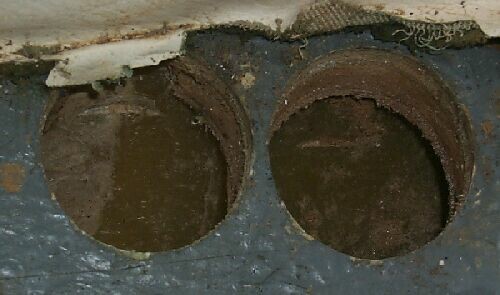
A closer look at the our bulkheads and floors confirmed that none of the hole penetrations were sealed with epoxy. With warmer weather, we started by properly cleaning, then sealing these hole edges. The holes to the left are found in the floor of the foc'shole (between #1 and #2 bulkhead), while the pair on the right can be found in the #2 bulkhead underneath the floor.
A view down the length of the bilge under the toilet. Just forward of bulkhead #3 you can see the water distribution hoses along with miscellaneous wiring to power lights and exhaust pumps. The small puddle is all that is left of bucketful's of sewage that seeped from the bilge under the holding tank. A set of stringer holes would have alerted us much earlier to the sewage problem in this and the preceding bilge. Also note that the fiberglass tabbing only goes so high in protecting the bulkhead.
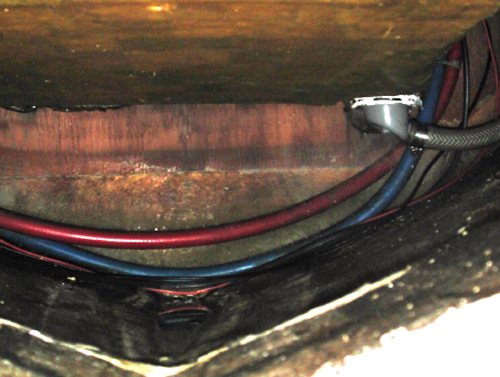
This picture also illustrates how Prout elected to save a few dollars by not better fixturing the parts that transverse this space. Installing a U-channel/bracket would have been very easy, inexpensive, and "quality enhancing" for the boat. Instead, the wires and the water hose can roll and chafe to their hearts content. The gray knob to the right is the drain underneath of the shower.
The solid nature of the whole compartment explains why we didn't notice the accumulated sewage before - it basically sat in here, air tight and evaporated slowly. With time, we will retrofit drains into this bulkhead and then pressure wash the whole compartment. This is yet another reason to have drain holes in your stringers and bulkheads. For damage control the paranoid can plug the holes in normal use.
Best Estimate of Time Required:
| Remove bilge cover, empty "secret holding tank" | 2 hours |
|---|---|
| Clean area with bleach, rinse, repeat | 1 hour |
| Retrofit proper drain for bilge | TBD |
| Retrofit proper support for hoses, electrical connections | TBD |
| Total | 3 hours |
|---|


